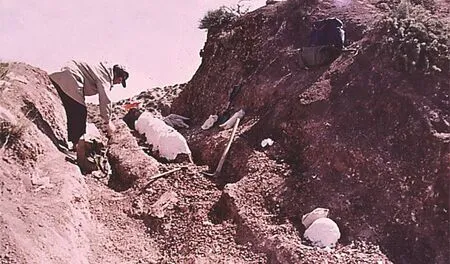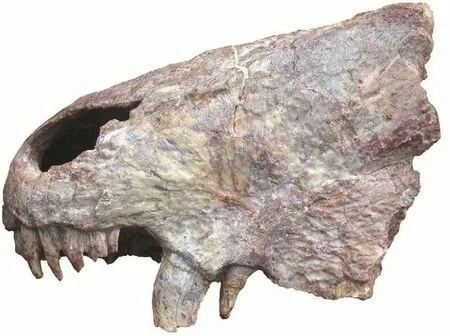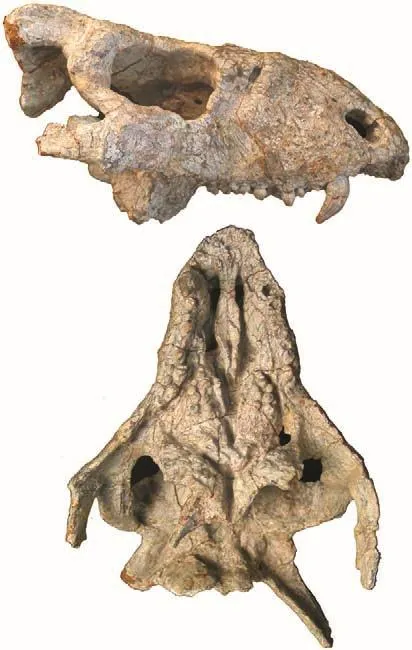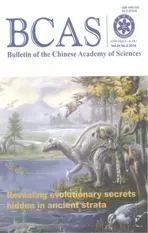Dashankou Fauna: A Unique Window on the Early Evolution of Therapsids
2010-12-30LIUJun
LIU Jun*
Institute of Vertebrate Paleontology and Paleoanthropology, CAS, Beijing 100044, China
In the 1980s, the Institute of Geology, Chinese Academy of Geological Sciences (IGCAGS)sent an expedition to the area north of the Qilian Mountains to study the local terrestrial Permian and Triassic deposits.A new vertebrate fossil locality, later named Dashankou Fauna, was discovered by Prof.CHENG Zhengwu in Dashankou,Yumen, Gansu Province in 1981.Small-scale excavations in 1981,1982 and 1985 demonstrated that this locality was a source of abundant and diverse vertebrate fossils.In the 1990s,supported by the National Natural Science Foundation of China, the IGCAGS, the Institute of Vertebrate Paleontology and Paleoanthropology(IVPP) under CAS, and the Geological Museum of China formed a joint team to work on this fauna.Three largescale excavations, undertaken in 1991, 1992, and 1995 respectively, as well as the subsequent ones held by IVPP were productive and have since unveiled an interesting episode in the transition from reptiles to mammals in evolutionary history.

Fig.1 Prof.LI Jinling in the excavation of 1995.She first summarized the known members of the Dashankou Fauna and brought it to light as the most primitive and abundant Chinese tetrapod fauna.
The results from these investigations were first disseminated to the public in 1995.In 2001, Prof.LI Jinling summarized the known members of the fauna and discussed their features.She pointed out thatthe fauna is dominated by therapsids(a kind of mammal-like reptiles) and is the most primitive and abundant Chinese tetrapod fauna.Recent studies of new therapsid materials from this locality have cast some new light on therapsid origins and highlighted the importance of this fauna.
The rich, nearly continuous 315-million-year fossil record documents the evolutionary history of a diverse clade of synapsid amniotes that includes extant mammals and their stem-group, often called “mammallike reptiles.” One of the major open questions in synapsid research is the presence of a morphological and temporal gap (known as the “Olson’s Gap”) between the earliest therapsids and their supposed sphenacodontiangrade ancestors.Even at their first appearance in the fossil record,therapsids had already diversified into several distinct groups including small and large herbivores and predators,i.e., Biarmosuchia, Dinocephalia,Anomodontia, and Theriodontia.
A remarkable specimen discovered at this locality, Raranimus dashankouensis (Liu, Rubidge & Li,2009) contributes to the diversity of this fauna and more importantly,might help filling in the Olson’s Gap.Comprising the partial snout of a tetrapod, the fragmentary specimen demonstrates a unique combination of therapsid and sphenacodontid features.The presence of a greatly elongated dorsal process of the premaxilla, a septomaxilla with a long facial process, and a high maxilla contacting the prefrontal distinguishes the specimen as a therapsid.However,Raranimus also has a number of sphenacodontid characters unknown in any other therapsid.This find helps us understand the morphological transition from pelycosaurs (basal mammal-like reptiles) to therapsids.If the acclaimed oldest known therapsid Tetraceratops (Laurin & Reisz,1996) is indeed a sphenacodont as recently suggested, our phylogenetic analysis shows the new specimen to be the most basal therapsid.The paper was ultimately published in Acta Palaeontologica Polonica.However, given that the material is fragmentary, stronger evidence for its therapsid affinities is needed for further discussion.We hope that more complete specimens of this species will come to light among the materials recently collected from the locality,to provide more clues about the morphological changes accompanying the pelycosaur-therapsid transition.

Fig.2 The fossil snout from the basalmost therapsid Raranimus dashankouensis in lateral view.This specimen enriches the morphological diversity of basal therapsids, a clade dubbed “mammal-like reptiles,” and casts new light on how they have evolved from their supposed sphenacodontian-grade ancestors.
Aside from the primitive therapsid Raranimus dashankouensis,the anomodont Biseridens qilianicus Li & Cheng, 1997 also deserves extra attention.
The therapsid clade Anomodontia(which includes the herbivorous Dicynodontia) is one of the most successful tetrapod taxa in terms of abundance of individuals, generic diversity and temporal duration.Anomodonts display a global distribution, being one of the very few tetrapod clades that occur on all continents, and have a long stratigraphic range extending from the Middle Permian to the Triassic and possibly even into the Cretaceous.The early evolution of anomodonts has been the subject of recent attention,and has been hotly debated as to whether the clade had a Laurasian or Gondwanan origin.
Biseridens qilianicus was initially described as an eotitanosuchian based on two fragmentary specimens, but later considered by some authors to be a basal anomodont closely related to Ulemica.Because of the poorly preserved nature of the material,however, neither proposal could be verified until quite recently when an additional specimen of Biseridens was recovered from the Dashankou locality.The new specimen shows a short snout, an elevated zygomatic arch, and a septomaxilla lacking an elongated posterodorsal process between the nasal and the maxilla,indicating that Biseridens is indeed an anomodont.Moreover, this wellpreserved specimen also offers some new clues for the origin and radiation of anomodonts, which have long been obscured by the lack of basal anomodant fossils.
Traditionally, the southern African therapsids were thought to have descended from basal therapsids that migrated into the region from the Northern Hemisphere.Building on the discovery of the primitive anomodont Patranomodon in Karoo of South Africa, some paleontologists proposed that anomodonts were dispersing freely between Europe and southern Africa in the Late Permian.Subsequent research, especially following the description of Anomocephalus from South Africa, supported the idea that anomodonts first evolved in African part of Gondwana.However,research by my group at the IVPP showed that Biseridens is the most basal known anomodont, indicating that anomodonts had a Laurasian rather than a Gondwanan origin.Meanwhile our studies highlighted the existence of two separate groups of anomodonts: the Venjukovioidea in Laurasia and the Chainosauria in Gondwanan.This suggests that there may have been two separate radiations of basal anomodonts from an ancestral Laurasian stock.Nevertheless, given that the most primitive dicynodonts were all found in Gondwana, we proposed that dicynodonts originated within the Gondwanan clade and later dispersed across Pangaea.This study was published in a special issue of the journal Proceedings of the Royal Society B: Biological Sciences, entitled ‘Recent advances in Chinese palaeontology,’ and was also highlighted by Nature.

Fig.3 The basalmost anomodont Biseridens qilianicus from Dashankou Fauna has inspired research into the origin and early radiation of this genus.As shown is its skull in lateral and ventral views.
Other taxa identified within this fauna so far include the temnospondyl Anakamacops petrolicus Li & Cheng,1999; the anthracosaurs Ingentidens corridoricus Li & Cheng, 1999 and Phratochronis qilianensis Li &Cheng, 1999; the captorhinomorph Belebey chengi Müller, Li & Reisz,2008; and the dinocephalians Stenocybus acidentatus Cheng & Li,1997 and Sinophonus yumenensis Cheng & Ji, 1996.
Comparing with other faunas, the Dashankou Fauna can be correlated to the Zone II of Russia and the Eodicynodon Assemblage Zone of South Africa, though slightly earlier.The Dashankou fauna is thought to be the earliest therapsid fauna, dating from the Roadian Age of the Middle Permian, and helps to fill in the Olson’s Gap.The small bolosaurid Belebey, a primitive anapsid reptile,is abundant and generally preserved as jaw fragments at the Dashankou locality.Previously this genus was only known from the Middle Permian of Russia.All known Dashankou therapsids are phylogenetically basal:they include the very basal therapsid Raranimus, the basal anteosaurid dinocephalians Stenocybus and Sinophoneus, and the basalmost anomodont Biseridens.
Our further research will incorporate more specimens in order to describe the diversity of the fauna more sufficiently and determine the phylogenetic positions of all known taxa in it more clearly.The current conclusion as to the age of the locality is solely based on correlations using vertebrate fossils.In the course of our future work we hope to find more evidence from geological data, and from correlations involving other groups such as fossil plants, that will enable us to corroborate our hypotheses.
Cheng, Z., P.Li, J.Li, S.Ji, and Y.Jin., 1995.Discovery of a new vertebrate fauna of Late Permian from western Gansu and its stratigraphic significance.Chinese Science Bulletin, 41(15): 1271–1275.
Laurin, M., and R.R.Reisz., 1990.Tetraceratops is the oldest known therapsid.Nature, 345: 249–250.
Laurin, M., and R.R.Reisz., 1996.The osteology and relationships of Tetraceratops insignis, the oldest known therapsid.Journal of Vertebrate Paleontology, 16(1):95–102.
Li, J., 2001.The most primitive lower tetrapod fauna in China.Science in China (Series D), 44(1): 47–51.
Liu, J., B.Rubidge, and J.Li., 2009.New basal synapsid supports Laurasian origin for therapsids.Acta Palaeontologica Polonica,54(3): 393–400.
Liu, J., B.Rubidge, and J.Li., 2010.A new specimen of Biseridens qilianicus indicates its phylogenetic position as the most basal anomodont.Proceedings of the Royal Society B: Biological Sciences, 277: 285–292.
杂志排行
Bulletin of the Chinese Academy of Sciences的其它文章
- Dinosaurs of a Feather
- The Origin and Diversification of Osteichthyans and Sarcopterygians:Rare Chinese Fossil Findings Advance Research on Key Issues of Evolution
- Amazing Reptile Fossils from the Marine Triassic of China
- Ongoing Research Projects at IVPP (A Selection)
- Advances in Vertebrate Paleontology and Paleoanthropology in China
- Recent Advances in Meso-Cenozoic Fish Research
